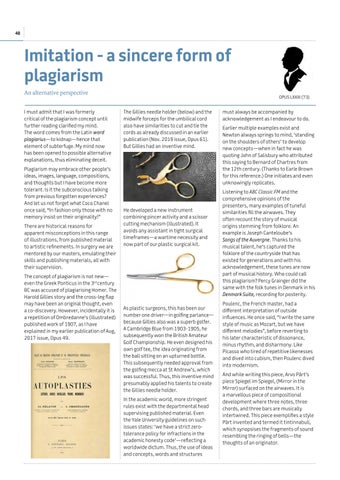48
Imitation - a sincere form of plagiarism An alternative perspective I must admit that I was formerly critical of the plagiarism concept until further reading clarified my mind. The word comes from the Latin word plagiarius—to kidnap—hence that element of subterfuge. My mind now has been opened to possible alternative explanations, thus eliminating deceit. Plagiarism may embrace other people’s ideas, images, language, compositions, and thoughts but I have become more tolerant. Is it the subconscious talking from previous forgotten experiences? And let us not forget what Coco Chanel once said, “In fashion only those with no memory insist on their originality!” There are historical reasons for apparent misconceptions in this range of illustrations, from published material to artistic refinements. In surgery we are mentored by our masters, emulating their skills and publishing materials, all with their supervision. The concept of plagiarism is not new— even the Greek Ponticus in the 3rd century BC was accused of plagiarising Homer. The Harold Gillies story and the cross-leg flap may have been an original thought, even a co-discovery. However, incidentally it is a repetition of Ombredanne’s (illustrated) published work of 1907, as I have explained in my earlier publication of Aug, 2017 issue, Opus 49.
OPUS LXXIII (73)
The Gillies needle holder (below) and the midwife forceps for the umbilical cord also have similarities to cut and tie the cords as already discussed in an earlier publication (Nov. 2019 issue, Opus 61). But Gillies had an inventive mind.
He developed a new instrument combining pincer activity and a scissor cutting mechanism (illustrated). It avoids any assistant in tight surgical timeframes—a wartime necessity and now part of our plastic surgical kit.
As plastic surgeons, this has been our number one driver—in golfing parlance— because Gillies also was a superb golfer. A Cambridge Blue from 1903-1905, he subsequently won the British Amateur Golf Championship. He even designed his own golf tee, the idea originating from the ball sitting on an upturned bottle. This subsequently needed approval from the golfing mecca at St Andrew’s, which was successful. Thus, this inventive mind presumably applied his talents to create the Gillies needle holder. In the academic world, more stringent rules exist with the departmental head supervising published material. Even the Yale University guidelines on such issues states: ‘we have a strict zerotolerance policy for infractions in the academic honesty code’—reflecting a worldwide dictum. Thus, the use of ideas and concepts, words and structures
must always be accompanied by acknowledgement as I endeavour to do. Earlier multiple examples exist and Newton always springs to mind, ‘standing on the shoulders of others’ to develop new concepts—when in fact he was quoting John of Salisbury who attributed this saying to Bernard of Chartres from the 12th century. (Thanks to Earle Brown for this reference.) One initiates and even unknowingly replicates. Listening to ABC Classic FM and the comprehensive opinions of the presenters, many examples of tuneful similarities fill the airwaves. They often recount the story of musical origins stemming from folklore. An example is Joseph Canteloube’s Songs of the Auvergne. Thanks to his musical talent, he’s captured the folklore of the countryside that has existed for generations and with his acknowledgement, these tunes are now part of musical history. Who could call this plagiarism? Percy Grainger did the same with the folk tunes in Denmark in his Denmark Suite, recording for posterity. Poulenc, the French master, had a different interpretation of outside influences. He once said, “I write the same style of music as Mozart, but we have different melodies”, before reverting to his later characteristic of dissonance, minus rhythm, and disharmony. Like Picasso who tired of repetitive likenesses and dived into cubism, then Poulenc dived into modernism. And while writing this piece, Arvo Pärt’s piece Spiegel im Spiegel, (Mirror in the Mirror) surfaced on the airwaves. It is a marvellous piece of compositional development where three notes, three chords, and three bars are musically intertwined. This piece exemplifies a style Pärt invented and termed it tintinnabuli, which synopsises the fragments of sound resembling the ringing of bells—the thoughts of an originator.


























